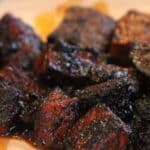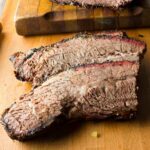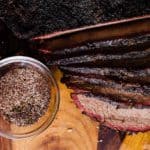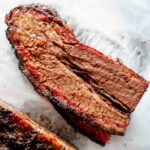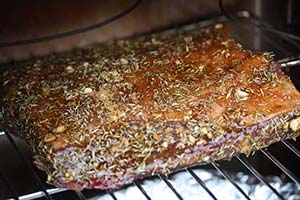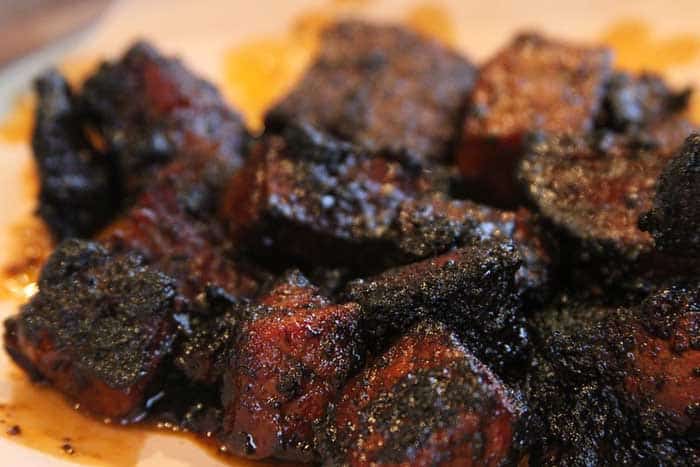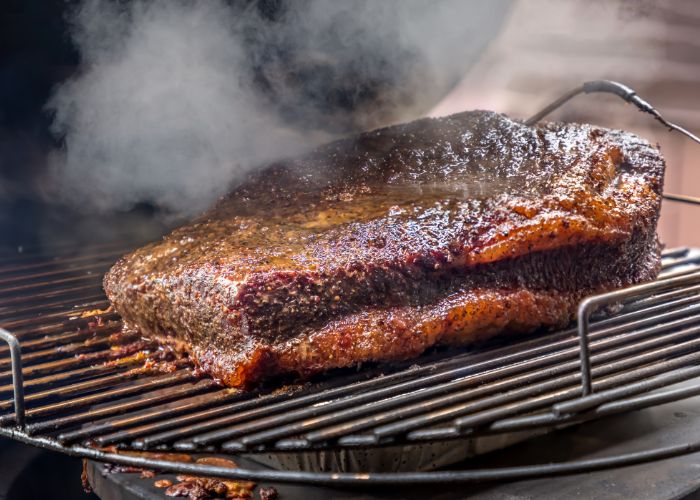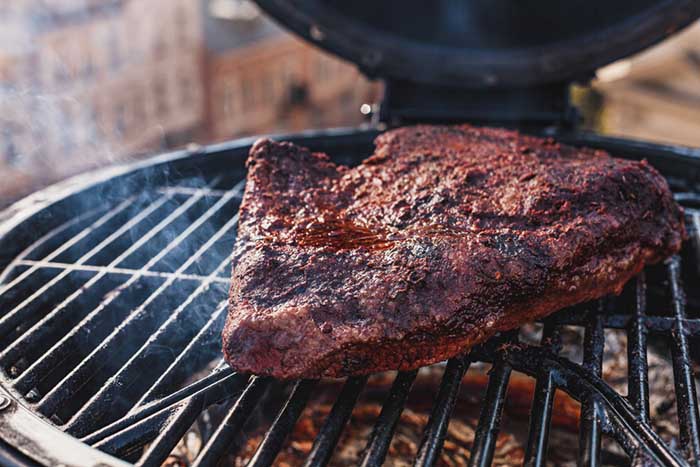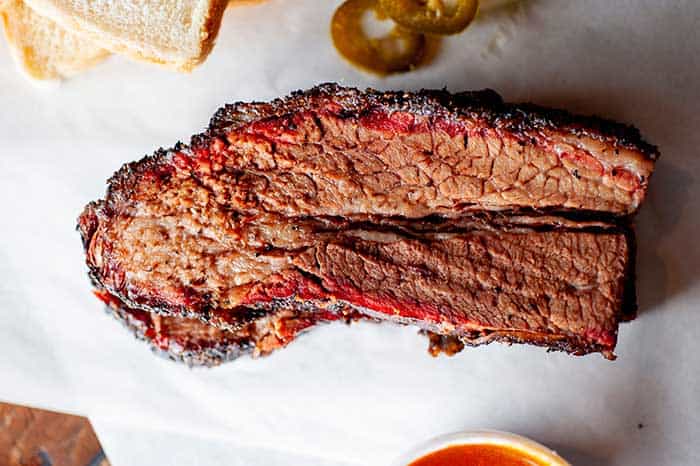Beef brisket is the staple dish of many a barbecue dinner platter, but did you know that brisket is actually made of two cuts of meat? Today we delve into the battle of the briskets and learn the differences between the brisket flat and the brisket point.
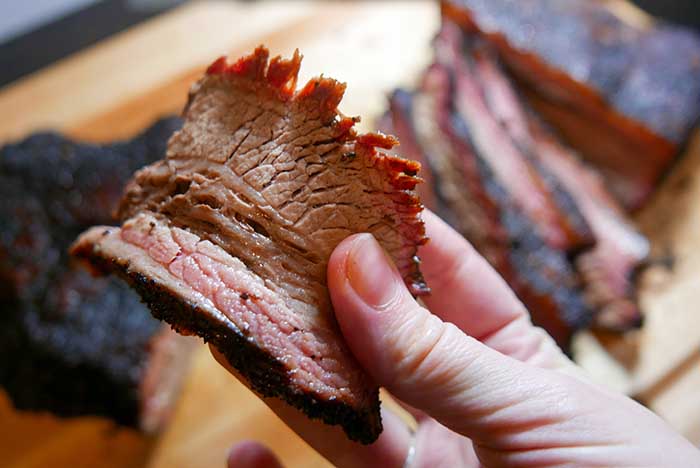
Brisket is one of those meat cuts that shows how a little bit of prep and patience can make a world of difference.
Historically brisket was not a sought-after cut, the old English word for it is ‘Brushk’, which means tough, and the Vikings would refer to it as cartilage or gristle. It doesn’t exactly make it sound appetizing, does it? They weren’t wrong though; any meat taken from the front of the cow is notoriously tough and, if cooked incorrectly, can be practically impossible to eat.
Nowadays, we know to use the low and slow cooking method to take this relatively inexpensive cut of meat and turn it into the moist and mouth-watering brisket recipes that people go crazy for.
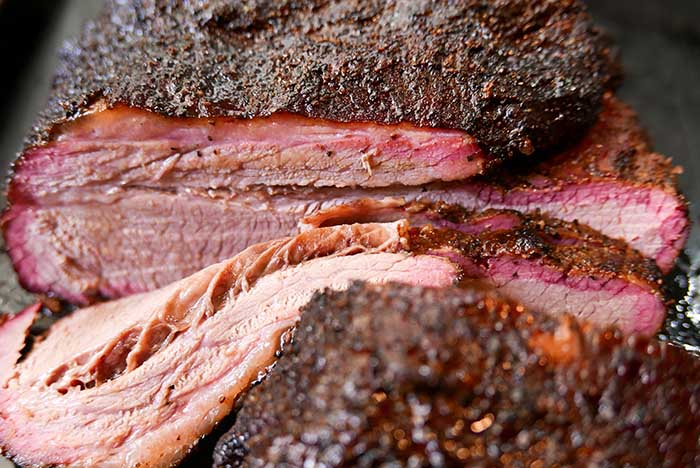
What is Brisket?
Brisket is a cut of meat that comes from the cow’s chest area. It is made up of a pair of muscles on the chest that also connects to the front legs. These muscles do a lot of work to help keep the cow standing upright, making it a very tough and dense cut with a lot of connective tissue. This is why beef brisket is a low and slow cooked cut; you need the prolonged heat to help breakdown the connective tissues and create the delicious brisket that we know and love.
The two muscles that make up the brisket are called the brisket flat and the brisket point, and although they are both hard-working muscles, they end up cooking in very different ways.
When you buy brisket at the supermarket, you will most often just find the brisket flat for sale. If you’re looking for brisket to cook on the BBQ, you are best off looking for the ‘Packer’s Cut’, which is both the flat and point together and untrimmed to ensure you get the best flavor, the best place to get a Packers Cut of brisket would be at a butchers.
Let’s take a closer look at the differences between both and how to best prepare and cook them.
What is the Brisket Flat?
The Brisket Flat is the main part of the brisket cut and is so-called because it is butchered off as a flat cut of meat that is around 1-2 inches thick. It is also sometimes known as the brisket first cut, brisket nose cut, or, if we’re getting scientific, the deep pectoral.
This muscle sits more inwards on the cow and lays against the ribs. It is a lean cut, meaning it’s low on fat and doesn’t hold much connective tissue, so if it’s not cooked correctly, it can end up being very tough.
That being said, there is visible marbling running through the brisket flat, and while the fat percentage is low, when cooked correctly, it can hold a great flavor and stay tender.
Uses for the Brisket Flat
Due to its shape and size, it is an excellent meat for slicing and is often used as deli meat, like a braised or slow-cooked joint, or as the delicious smoked BBQ delicacy we all know and love.
The History Of the Brisket Flat as a Passover Staple
The brisket flat has a long tradition of being a staple food on the Passover table for many Jewish families. When it comes to beef, Jewish customs mean that there are fewer cuts to choose from as a large amount of the cow is not considered kosher.
Brisket is one of the kosher cuts of beef as it comes from the front of the cow, and it has also historically been one of the more affordable cuts of meat (as it is a heavily worked muscle that takes longer to cook). This has resulted in brisket being a staple food for many central and eastern European Jews since the 1700s, especially for food-based celebrations such as Passover, where large groups of friends and family would come together and have a larger meal.
Preparing a Brisket Flat
The preparation of a brisket flat is relatively minimal when it comes to trimming up; it already has less fat on the outside of the cut, thanks to the way that it is butchered. If there is a bit left on there, you can remove it if you want to, but it’s worth remembering that any fat left on while cooking will help to keep the meat moist. The more important part to remove is any remaining silver skin; you want this removed as otherwise it’ll hold the fiber of the meat together and make it seem chewy.
Flavoring your brisket flat depends on what you plan to use it for.
If you plan to use it to make pastrami, you would brine it; if you are planning to braise or slow roast it, you might look to make a marinade.
If you are planning on a low and slow cook, you’ll want to apply a dry rub to help create a nice bark during the smoking process.
How to Smoke a Brisket Flat
To smoke a brisket flat with optimum success takes a bit of time, but the results are well worth it. You’ll want to start your meat smoking at a low temperature of around 107-135c (225-275f) for as long as it takes for the internal temperature of the brisket to reach 95c (203f). It’s worth considering wrapping your brisket to help avoid the ‘Stall’; the Texas Crutch method is an ideal way of beating the stall and making sure your brisket remains moist.
What is Brisket Point?
The Brisket Point is the portion of the whole brisket cut that sits above the leg of the cow. It can also be known as the Deckle, fat end, second cut, triangular cut, or its scientific name, the superficial pectoral.
Calling it the Point or Triangular does a good job of describing how this cut looks. It’s smaller and thicker than the brisket flat but has a higher fat content with a lot more marbling and connective tissue. As a result, it provides less meat than the flat cut, but the meat it does produce has a more juicy texture and stronger flavor.
Uses for the Brisket Point
The higher fat content of the brisket point means it lends itself more to shredding than being sliced as it gives a better texture when eating.
That’s not to say that it can’t ever be sliced, though! One of the most popular uses for the brisket point is to cut it into cubes to make delicious Burnt Ends.
Preparing a Brisket Point
Since the brisket point is often served as shredded or used to make Burnt Ends, there is no need to trim off any extra fat as it all adds to the finished flavor of the meat.
Most people will opt for a dry rub when seasoning brisket point as it allows it to build up a tasty bark.
How to Smoke a Brisket Point
The brisket point needs to be cooked low and slow to make sure that the fats and connective tissue break down to create that delicious, tender finish we’re after. Much like the flat, brisket point can benefit from being wrapped to avoid the ‘stall’. Start it in the smoker at a low temperature of around 107-135c (225-275f) and keep it cooking until the brisket’s internal temperature reaches 95c (203f).
How To Make Brisket Burnt Ends
Making brisket burnt ends follows the same steps as above, but you stop once you are about 80% of the way done. You remove the almost-done brisket from the smoker, cut it into 1-inch cubes, and toss it in the sauce before returning it to the smoker to finish cooking and allow the sauce to caramelize.
Brisket Flat vs. Point – The Battle of the Briskets
Let’s give a quick rundown on the ‘Battle of the Briskets’
Easiest To Cook
When it comes to coking the brisket flat and the brisket point, they are both done in the same sort of ways – both can be smoked, but the flat also does well as a braised or slow-roasted dish. Which is easier to cook is more of a personal preference on what method best suits your skillset.
Fat Content
The point has a higher fat content than the flat thanks to the marbling that runs through it. This means that the point is less likely to dry out while cooking, but as long as both cuts are cooked low and slow, the difference in fat content isn’t a significant issue.
Best Taste
General consensus gives a clear win to the brisket point when it comes to which cut has the best flavor. Its extensive marbling and the fact that it is just fattier in general means that it naturally holds more flavor and produces juicier and more buttery texture than the brisket fat does.
How to Separate Brisket Point & Flat
If you’ve bought a ‘Packer’s’ cut of brisket, you’ll want to separate the brisket point and flat before cooking to get the best out of both cuts.
Splitting a brisket takes a bit of practice, but with the help of a sharp knife and these step-by-step instructions, you’ll be ready to get smoking in no time at all.
1. Identify Your Cuts
First, you need to identify which piece is which on your brisket. Lay the brisket on your workspace with the fattier side down. With the fattier side down, the flat lays on top of the point (remember how we said before that the flat lays against the ribs, and the point sits at the top of the leg), and you’ll be able to see a seam of fat where the two come together. That seam is referred to as the nose.
2. Cut down the ‘Nose’
That fat seam is the point where you want to separate the two cuts. Take a sharp knife and start cutting downwards into that seam and follow it along as it curves back and under the flat. To make this easier for yourself, you want to lift the flat with your other hand as you are slicing so that you can see where the fat seam is running. It will eventually get thinner and to a point where it tapers out – once you cut to there, you will have two separate pieces of meat.
3. Trim Up
Depending on how closely you cut to that fat seam, you might have excess fat left on both cuts. Give them a trim up and remove any unnecessary fat.
